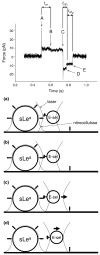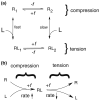The Effects of Load on E-Selectin Bond Rupture and Bond Formation
- PMID: 20526425
- PMCID: PMC2880517
- DOI: 10.1007/s12195-010-0110-6
The Effects of Load on E-Selectin Bond Rupture and Bond Formation
Abstract
Molecular dissociation rates have long been known to be sensitive to applied force. We use a laser trap to provide evidence that rates of association may also be force-dependent. We use the thermal fluctuation assay to study single bonds between E-selectin and sialyl Lewis(a) (sLe(a)), the sugar on PSGL-1 to which the three selectins bind. Briefly, an E-selectin-coated bead is held in a laser trap and pressed with various compressive loads against the vertical surface of a bead coated with sLe(a). The time it takes for a bond to form is used to calculate a specific two-dimensional on-rate, kono. We observe an increase in kono with increasing compressive force, providing single molecule evidence that on-rate, in addition to off-rate, is influenced by load. By measuring bond lifetimes at known tensile loads, we show that E-selectin, like its family members L- and P-selectin, is capable of forming catch bonds. Our data support a reverse Bell model, in which compressive forces lower the activation energy for binding. Load-dependent on-rates may be a general feature of all intermolecular bonds.
Figures





Similar articles
-
A High-Throughput Technique Reveals the Load- and Site Density-Dependent Kinetics of E-Selectin.Cell Mol Bioeng. 2012 Dec;5(4):493-503. doi: 10.1007/s12195-012-0247-6. Cell Mol Bioeng. 2012. PMID: 24511329 Free PMC article.
-
The molecular mechanics of P- and L-selectin lectin domains binding to PSGL-1.Biophys J. 2004 Jan;86(1 Pt 1):544-54. doi: 10.1016/S0006-3495(04)74133-8. Biophys J. 2004. PMID: 14695299 Free PMC article.
-
[Measuring rupture forces of P-selectin/PSGL-1 bonds using an optical trap assay].Sheng Wu Yi Xue Gong Cheng Xue Za Zhi. 2005 Oct;22(5):961-5. Sheng Wu Yi Xue Gong Cheng Xue Za Zhi. 2005. PMID: 16294731 Chinese.
-
For catch bonds, it all hinges on the interdomain region.J Cell Biol. 2006 Sep 25;174(7):911-3. doi: 10.1083/jcb.200609029. J Cell Biol. 2006. PMID: 17000873 Free PMC article. Review.
-
Theoretical aspects of the biological catch bond.Acc Chem Res. 2009 Jun 16;42(6):693-703. doi: 10.1021/ar800202z. Acc Chem Res. 2009. PMID: 19331389 Review.
Cited by
-
Targeting Neutrophil Adhesive Events to Address Vaso-Occlusive Crisis in Sickle Cell Patients.Front Immunol. 2021 Apr 28;12:663886. doi: 10.3389/fimmu.2021.663886. eCollection 2021. Front Immunol. 2021. PMID: 33995392 Free PMC article. Review.
-
Molecular mechanisms of catch bonds and their implications for platelet hemostasis.Biophys Rev. 2023 Sep 26;15(5):1233-1256. doi: 10.1007/s12551-023-01144-8. eCollection 2023 Oct. Biophys Rev. 2023. PMID: 37974999 Free PMC article. Review.
-
Dual Affinity Nanoparticles for the Transport of Therapeutics from Carrier Cells to Target Cells under Physiological Flow Conditions.ACS Omega. 2023 Nov 1;8(45):42748-42761. doi: 10.1021/acsomega.3c05605. eCollection 2023 Nov 14. ACS Omega. 2023. PMID: 38024679 Free PMC article.
-
What's the Catch? The Significance of Catch Bonds in T Cell Activation.J Immunol. 2023 Aug 1;211(3):333-342. doi: 10.4049/jimmunol.2300141. J Immunol. 2023. PMID: 37459191 Free PMC article. Review.
-
Receptor-Ligand Binding: Effect of Mechanical Factors.Int J Mol Sci. 2023 May 21;24(10):9062. doi: 10.3390/ijms24109062. Int J Mol Sci. 2023. PMID: 37240408 Free PMC article. Review.
References
Grants and funding
LinkOut - more resources
Full Text Sources

